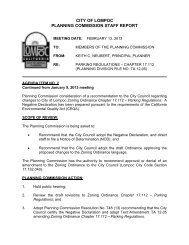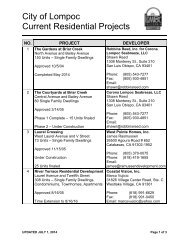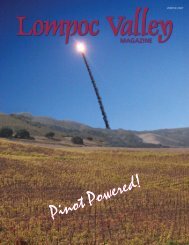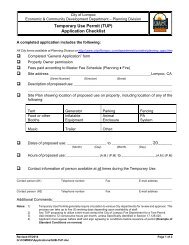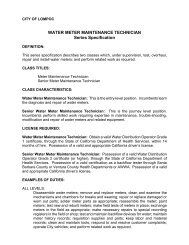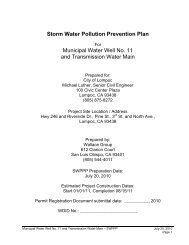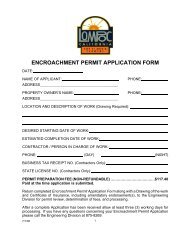Noise and Air Quality - the City of Lompoc!
Noise and Air Quality - the City of Lompoc!
Noise and Air Quality - the City of Lompoc!
- No tags were found...
Create successful ePaper yourself
Turn your PDF publications into a flip-book with our unique Google optimized e-Paper software.
<strong>City</strong> <strong>of</strong> <strong>Lompoc</strong> General Plan UpdateIssue Paper on <strong>Noise</strong> <strong>and</strong> <strong>Air</strong> <strong>Quality</strong> Issues• By 2010, reduce greenhouse gas emissions to 2000 levels.• By 2020, reduce greenhouse gas emissions to 1990 levels.• By 2050, reduce greenhouse gas emission to 80 percent below 1990 levels.In response to <strong>the</strong> Executive Order, Cal/EPA established <strong>the</strong> Climate Action Team to developstrategies for reducing climate change emissions in <strong>the</strong> State. In March 2006, Cal/EPA releaseda document called <strong>the</strong> Climate Action Team Report to Governor Schwarzenegger <strong>and</strong>Legislature. The Report provides suggested strategies for reducing climate change emissionsthat would be implemented by State agencies over <strong>the</strong> next 2 years. It is a guidance documentto be used by <strong>the</strong> identified State agencies in developing statewide programs for reducingclimate change emissions.The Executive Order also directed <strong>the</strong> California Environmental Protection Agency (Cal/EPA) tocoordinate efforts among State agencies to meet <strong>the</strong>se targets. As part <strong>of</strong> this directive, in 2006<strong>the</strong> California State Legislature adopted AB 32, <strong>the</strong> California Global Warming Solutions Act <strong>of</strong>2006, which <strong>the</strong> Governor signed on September 27, 2006. AB 32 represents <strong>the</strong> firstenforceable statewide program to limit GHG emissions from all major industries with penaltiesfor noncompliance. It requires Cal/EPA to lead <strong>the</strong> evaluation <strong>of</strong> California’s impacts on climatechange <strong>and</strong> identify mitigation strategies to reduce emissions <strong>and</strong> adaptive measures tominimize adverse effects <strong>of</strong> climate change. The California <strong>Air</strong> Resources Board (CARB) hasbeen assigned to carry out <strong>and</strong> develop <strong>the</strong> programs <strong>and</strong> requirements necessary to achieve<strong>the</strong> goals <strong>of</strong> AB 32. By January 2008, a statewide cap for 2020 emissions based on 1990 levelsmust be adopted. The following year (January 2009), CARB must adopt m<strong>and</strong>atory reportingrules for major sources <strong>of</strong> GHGs <strong>and</strong> also a plan indicating how reductions in significant GHGsources will be achieved through regulations, market mechanisms, <strong>and</strong> o<strong>the</strong>r actions.Relationship to <strong>the</strong> General Plan<strong>Noise</strong><strong>Noise</strong> is <strong>of</strong> special concern to <strong>the</strong> State with respect to General Plans. It is one <strong>of</strong> <strong>the</strong> seventopics required to be addressed in a specific Element under state planning law. The State Office<strong>of</strong> Planning <strong>and</strong> Research <strong>Noise</strong> Element Guidelines require that major noise sources beidentified <strong>and</strong> quantified through <strong>the</strong> preparation <strong>of</strong> generalized noise contours for current <strong>and</strong>projected conditions. This is intended to guide <strong>the</strong> l<strong>and</strong> use pattern in order to minimize <strong>the</strong>community’s exposure to current noise issues, as well as shield <strong>the</strong> community from noisecreated by future development. L<strong>and</strong> use changes identified in <strong>the</strong> Housing Element <strong>and</strong> L<strong>and</strong>Use Element can result in noise increases directly (e.g., from zoning <strong>of</strong> additional industrialnoise sources) <strong>and</strong> indirectly (e.g., from vehicle trips associated with future development). Inaddition, transportation improvements identified in <strong>the</strong> Circulation Element (e.g., road wideningsor extensions) could bring traffic noise sources closer to existing or planned receptors. The<strong>Noise</strong> Element acts in concert with <strong>the</strong>se elements to ensure that <strong>City</strong> noise st<strong>and</strong>ards are metthroughout <strong>the</strong> General Plan buildout period. It should be noted that <strong>the</strong> first phase <strong>of</strong> <strong>the</strong>General Plan Update process includes updating <strong>the</strong> Housing, L<strong>and</strong> Use, <strong>and</strong> CirculationElements, <strong>and</strong> <strong>the</strong> subsequent phase includes updating <strong>the</strong> <strong>Noise</strong> Element. The EnvironmentalImpact Report for <strong>the</strong> first phase element will identify noise impacts associated with updated5<strong>City</strong> <strong>of</strong> <strong>Lompoc</strong>



